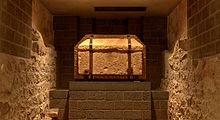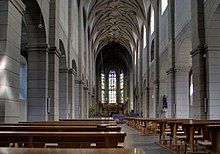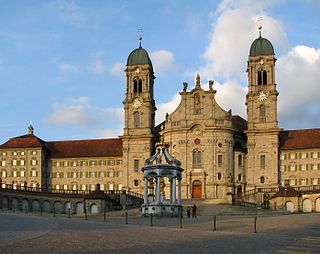
Einsiedeln Abbey is a Roman Catholic monastery administered by the Benedictine Order in the village of Einsiedeln, Switzerland. The abbey is dedicated to Our Lady of the Hermits, in recognition of Meinrad of Einsiedeln, a hermit Catholic saint. The monastery is not under the jurisdiction of a diocese or a bishop because it is a territorial abbey.

Downside Abbey is a Benedictine monastery in England and the senior community of the English Benedictine Congregation. Until 2019, the community had close links with Downside School, for the education of children aged eleven to eighteen. Both the abbey and the school are at Stratton-on-the-Fosse, between Westfield and Shepton Mallet in Somerset, South West England. In 2020, the monastic community announced that it would move away from the present monastery and seek a new place to live. On 27 October 2021, the monastic community further announced that as part of their transition they would move in Spring of 2022 to the temporary accommodation of "Southgate House, in the grounds of Buckfast Abbey, Devon, where we will live as the Community of St Gregory the Great". As of 2020, the monastic community of Downside Abbey was home to fifteen monks.
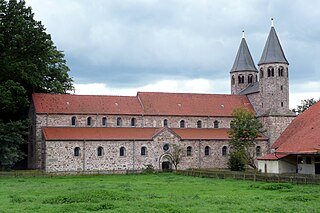
Bursfelde Abbey is a former Benedictine monastery located in Bursfelde, a hamlet which for administrative purposes is included in the municipality of nearby Hannoversch Münden in Lower Saxony, Germany. Today the abbey church and its estate cover a site of approximately 300 hectares which is administered by the Klosterkammer Hannover, a body that operates under the auspices of the Lower Saxony Ministry for Arts and the Sciences to look after reassigned or disused ecclesiastical buildings and other heritage properties in the region. The legal owner of the Bursfelde Monastery Complex is the Evangelical-Lutheran Church of Hanover.

Huysburg is a Benedictine monastery situated on the Huy hill range near Halberstadt, in the German state of Saxony-Anhalt. The Romanesque abbey has existed since about 1080 and was secularised in 1804. A new Benedictine community was founded in 1972 and has been headed by a prior since 1984.

The Beuronese Congregation, or Beuron Congregation, is a union of mostly German or German-speaking monasteries of both monks and nuns within the Benedictine Confederation. The congregation stands under the patronage of Martin of Tours, who is the patron saint of the Archabbey of Beuron.

Tholey Abbey in Tholey, in the district of Sankt Wendel in Saarland, is a Benedictine monastery dedicated to Saint Maurice. It is part of the Beuronese Congregation within the Benedictine Confederation.

The Bursfelde Congregation, also called Bursfelde Union, was a union of predominantly west and central German Benedictine monasteries, of both men and women, working for the reform of Benedictine practice. It was named after Bursfelde Abbey.

Maredsous Abbey is a Benedictine monastery at Maredsous, in the municipality of Anhée, Wallonia, Belgium. It is a founding member of the Annunciation Congregation of the Benedictine Confederation.

Tholey is a municipality in the district of Sankt Wendel, in Saarland, Germany. It is situated approximately 10 kilometres (6.2 mi) west of Sankt Wendel, and 30 kilometres (19 mi) north of Saarbrücken.

Mondsee Abbey was a Benedictine monastery in Mondsee in Upper Austria.

Seitenstetten Abbey is a Benedictine monastery in Seitenstetten in the Mostviertel region of Lower Austria.

Saint Paul's Abbey in Lavanttal is a Benedictine monastery established in 1091 near the present-day market town of Sankt Paul im Lavanttal in the Austrian state of Carinthia. The premises centered on the Romanesque monastery church were largely rebuilt in a Baroque style in the 17th century.

Ligugé Abbey, formally called the Abbey of St. Martin of Ligugé, is a French Benedictine monastery in the Commune of Ligugé, located in the Department of Vienne. Dating to the 4th century, it is the site of one of the earliest monastic foundations in France. The original abbey having been destroyed during the French Revolution, the current monastic community dates from 1853, and belongs to the Solesmes Congregation.

Solesmes Abbey or St. Peter's Abbey, Solesmes is a Benedictine monastery in Solesmes, Sarthe, France, famous as the source of the restoration of Benedictine monastic life in the country under Dom Prosper Guéranger after the French Revolution. The current abbot is the Right Reverend Dom Abbot Geoffrey Kemlin, O.S.B., elected in 2022.
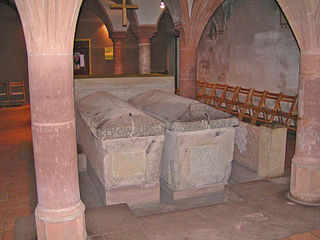
Saint Eucharius is venerated as the first bishop of Trier. He lived in the second half of the 3rd century.

Lamspringe Abbey is a former religious house of the English Benedictines in exile, at Lamspringe near Hildesheim in Germany.

The Abbey of Santa Giustina is a 10th-century Benedictine abbey complex located in front of the Prato della Valle in central Padua, region of Veneto, Italy. Adjacent to the former monastery is the basilica church of Santa Giustina, initially built in the 6th century, but whose present form derives from a 17th-century reconstruction.

The Congregation of the Annunciation, formerly known as the Belgian Congregation, is a congregation of monasteries within the Roman Catholic Benedictine Confederation. Founded in 1920, the Congregation includes fifteen independent male monasteries spread throughout ten countries. Additionally, two female monasteries are members of the Congregation, while a further ten are affiliated with the Congregation.

Hornbach Abbey is a former monastery founded around 741 in the historic town of Gamundias by Saint Pirmin, which soon became a Benedictine abbey. The most important neighbouring abbeys were Bausendorf, Saint-Avold, Glandern, Villers-Bettnach, Fraulautern, Mettlach, Tholey, and the stift of St. Arnual. The neighboring spiritual centers were Trier and Metz. At present, all that remains of Hornbach Abbey are the structural remains of the convent buildings, which have been supplemented by a monastery museum, and a modern chapel with the historical tomb of the monastery's founder.






